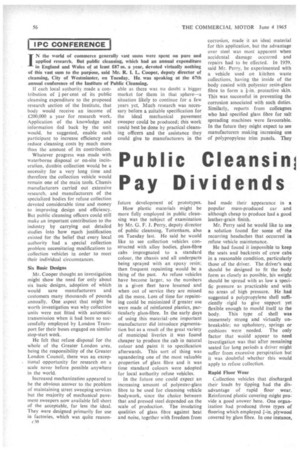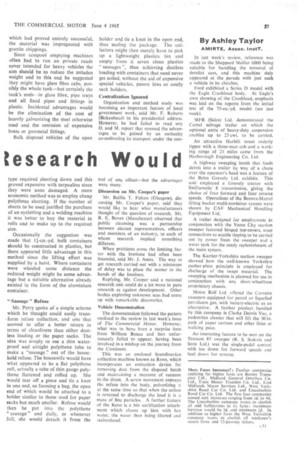Public Cleansini Pay Dividends tesearch Would
Page 58

Page 59

If you've noticed an error in this article please click here to report it so we can fix it.
future development of prototypes.
How plastic materials might be more fully employed in public cleansing was the subject of examination by Mr. G. F. J. Perry, deputy director of public cleansing, Tottenham, also on Tuesday last. He said he would like to see collection vehicles constructed with alloy bodies, glass-fibre cabs impregnated to a standard colour, the chassis and all underparts being sprayed with an epoxy resin; then frequent repainting would be a thing of the past. As refuse vehicles have become larger, so the numbers in a given fleet have lessened and when out of service they are missed all the more. Loss of time for repainting could be minimized if greater use were made of reinforced plastics, particularly glass-fibre. In the early days of using this materialo one important manufacturer did introduce pigmentation but as a result of the great variety of municipal liveries it was found cheaper to produce the cab in natural colour and paint it to specification afterwards. This sort of thing was squandering one of the most valuable properties of glass fibre and it was time standard colours were adopted for local authority refuse vehicles.
In the future one could expect an increasing amount of polyester-glass fibre to be used for cleansing vehicle bodywork, since the choice between that and pressed steel depended on the scale of production. The insulating qualities of glass fibre against heat and noise, together with freedom from
had made their appearance in a popular mass-produced car and although cheap to produce had a good leather-grain finish.
Mr. Perry said he would like to see a solution found for some of the recurring headaches that occurred in refuse vehicle maintenance. •
He had found it impossible to keep the seats and backrests of crew cabs in a reasonable condition, particularly those of the driver. The driver's seat should be designed to fit the body form as closely as possible, his weight should be spread with as low a specific pressure as practicable and with no areas of high pressure. He had suggested a polypropylene shell sufficiently rigid to give support yet flexible enough to mould itself to the body. This type of shell was immensely strong and virtually unbreakable; no upholstery, springs or cushions were ,needed. The only factor that would appear to need investigation was that after remaining seated for long periods a driver might suffer from excessive perspiration but it was doubtful whether this would apply to refuse collection.
Rapid Floor Wear Collection vehicles that discharged their loads by tipping had the disadvantage of rapid floor wear. Reinforced plastic covering might pro-• vide a good answer here. One organization had produced three types of flooring which employed ;1-in. plywood covered by glass fibre. In one instance,
type required sheeting down and this proved expensive with tarpaulins since they were soon damaged. A more economic method was to employ cheap polythene sheeting. If the number of sheets to be used justified the purchase of an eyeletting and a welding machine it was better to buy the material in rolls and to make up to the required size.
Occasionally the suggestion was made that 11-cu.-yd. bulk containers should be constructed in plastics, but there appeared little advantage in this method since the lifting effort was supplied by a hoist. Where containers were wheeled some distance the reduced weight might be some advantage but a suitable alternative already existed in the form of the aluminium container.
" Sausage " Refuse Mr. Perry spoke of a simple scheme which he thought could easily transform refuse collection, and one that seemed to offer a better return in terms of cleanliness than either dustless loading or the paper sacks. The idea was simply to use a thin waterproof and airtight polythene tube to make a "sausage .7 out of the household refuse. The housewife would have what appeared to be a flat polythene roll, actually a tube of thin gauge polythene flattened and rolled up. She would tear off a piece and tie a knot in one end, so forming a bag, the open end of which would be attached to a holder similar to those used for paper sacks but much smaller. Refuse would then be put into the polythene " sausage " and daily, or whenever full, she would detach it from the
trot of one officer—but the advantages were many.
Discussion on Mr. Cooper's paper
Mr. Baillie T. Fulton (Glasgow), discussing Mr. Cooper's paper, said they would like to hear what manufacturers thought of the question a research. Mr. R. E. Bevan (Manchester) observed that public cleansing was a partnership between elected representatives, officers and members of an industry, to each of whom research implied something different.
When problems arose the limiting factor with the Institute had often been financial, said Mr. J. Ames. The way to get research carried out with a minimum of delay was to place the matter in the hands of the Institute.
Replying, Mr. Cooper said a national research unit could do a lot more in pure research as against development. Other bodies exploring unknown seas had come up with remarkable discoveries.
Vehicle Demonstration
The demonstration followed the pattern outlined in the review in last week's issue of The Commercial Motor. However, what was to have been a surprise item from William Bunce and Son unfortunately failed to appear, baying been involved in a mishap on the journey from the Continent.
This was an enclosed Scandinavian collection machine known as Reno, which incorporates an extraction device for removing dust from the disposal hatch and maintaining a measure of vacuum in the drum. A screw movement conveys the refuse into the body, pulverizing it at the same time so that when the action is reversed to discharge the load it is a mass of fine particles. A further feature of the Reno is a bin sterilization attachment which cleans up bins with hot water, the water then being filtered and recirculated.
























































































































